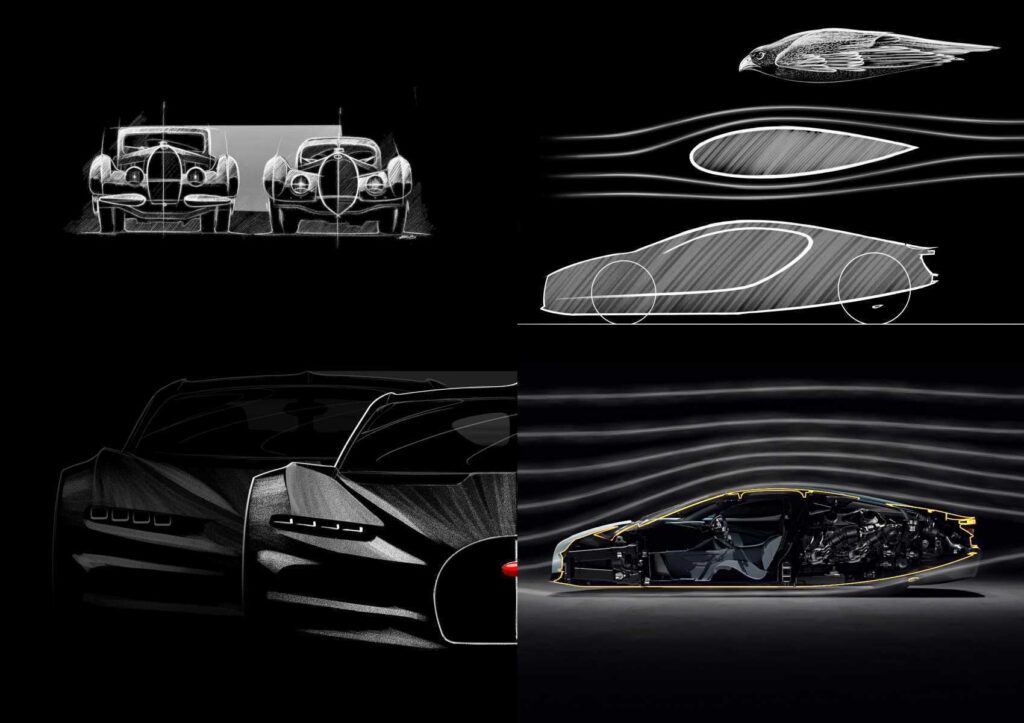If you’ve followed Bugatti’s design evolution as a brand through the generations, you know that beyond art form, innovation and fastidious build quality, aerodynamics has been at the very core of the French marque from the onset for conceiving some of the fastest cars on the planet for well over a century.
Jean Bugatti pioneered the Surbaissé concept back in the 1930s, where he lowered the Type 57 SC Atlantic’s profile to aid with speed and efficiency. That same principle is what drove the design philosophy when designing Bugatti’s latest hypercar, the Tourbillon.
“By submerging the engine below and behind the front axle, the hood, driver, and roof could be lowered, maximizing aerodynamic efficiency. It was unlike any other car of the time. And that same philosophy has been applied to the Tourbillon.” – Bugatti Design Director, Frank Heyl.
The inspiration for the overall shape of the Tourbillon comes from nature, the peregrine falcon, to be more specific. Just as the bird tucks its wings to reduce frontal area during a dive, Bugatti’s latest flagship employs a narrowed teardrop profile to cut drag, while still housing a comfortable cockpit. That pursuit of efficiency dictated not just the exterior, but the way the cabin itself was packaged.
Sitting 1.3 inches lower than the outgoing Chiron, the seats in the Tourbillon are fixed directly to the carbon monocoque, while the pedals and steering wheel adjust longitudinally. Simulating the posture of a single-seater race car, this layout keeps the driver close to the ground while allowing for a considerably low-slung stance.
Building upon what the Veyron and Chiron have achieved over the past two decades, the engineering challenge at speeds in excess of 270 mph is as much about physics as design. At those speeds, the car generates enough lift to take flight like an aircraft. Hence, a neutral aero balance becomes a critical element. Too much lift and the car is airborne, where as too much downforce and you end up overloading the tires.
The solution comes in an innovative diffuser system more than six feet long, running from under the cabin to a tall exit at the rear. Frank highlights how the exhaust gases feed into it, accelerating airflow and aid with maximizing downforce without excessive drag. Even the new wider and lower horseshoe grille serves a purpose, channeling air efficiently through dual radiators.
Bugatti also eliminated a traditional rear crash beam, instead designing diffuser fins strong enough to absorb crash energy, an unusual safety solution that doubles as an aero device. This approach allows the Tourbillon to maintain a flush rear wing at top speed. The wing only deploys for handling or in situations needing the air brake, but never for straight-line stability.
As for performance, the Tourbillon debuts an all-new naturally aspirated V16 paired with hybrid assistance, and has a combined output of 1,800 horsepower, a worthy successor to the enduring legacy of the mighty quad-turbo W16 that powered the Veyron and Chiron from the Pïech-era. Inside, Bugatti resisted industry trends toward all-digital cockpits. Instead, the Tourbillon features an exposed mechanical instrument cluster (hence the namesake) with intricate dials and gears drawing from the world of horology.
This singular detail alone should help the Tourbillon endure generations, and fits into the brand’s commitment to timelessness while offering owners a tactile connection often missing from modern hypercars. Only 250 will be built, each starting at roughly $4 million, and Sur Mesure, Bugatti’s in-house customization division, will further aid in ensuring exclusivity through bespoke commissions, as highlighted on the recently unveiled one-off Brouillard at the Quail.
Source: Bugatti
